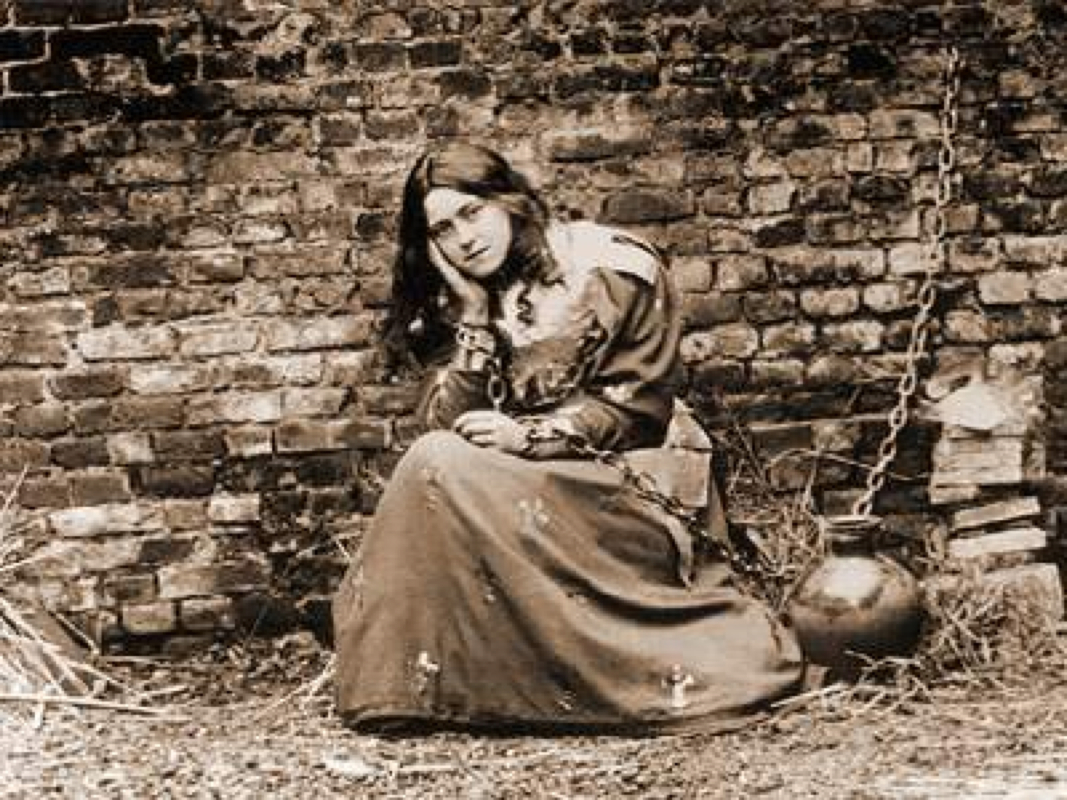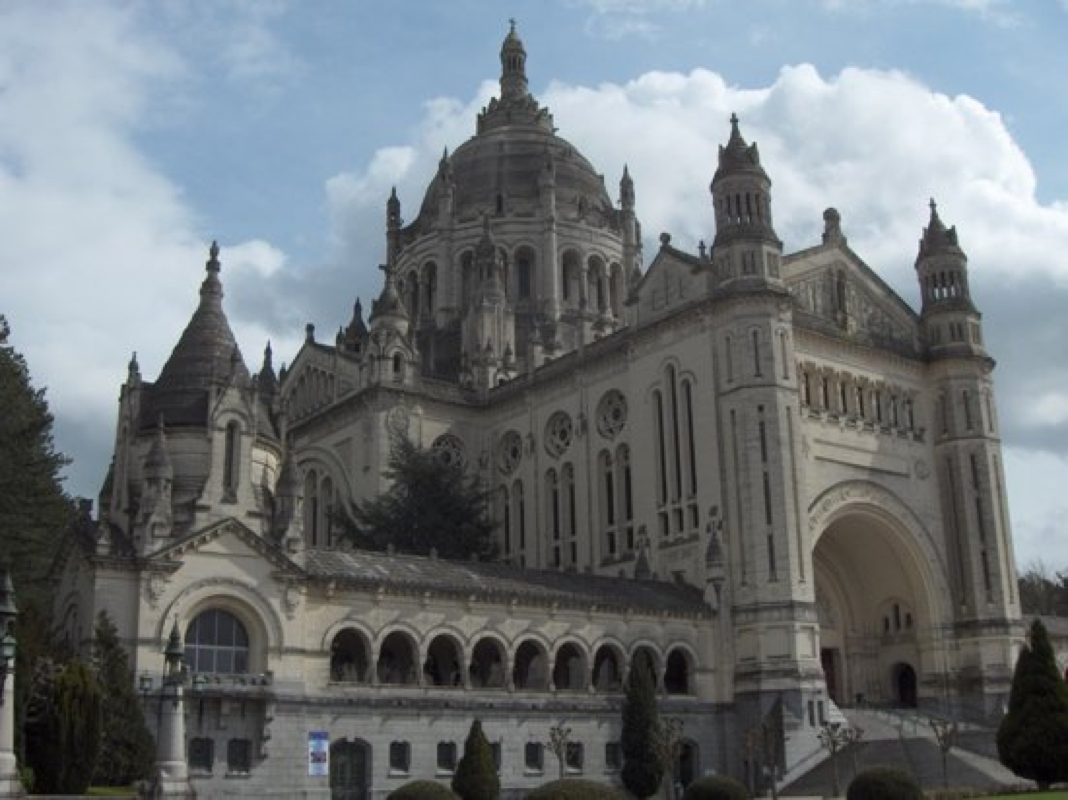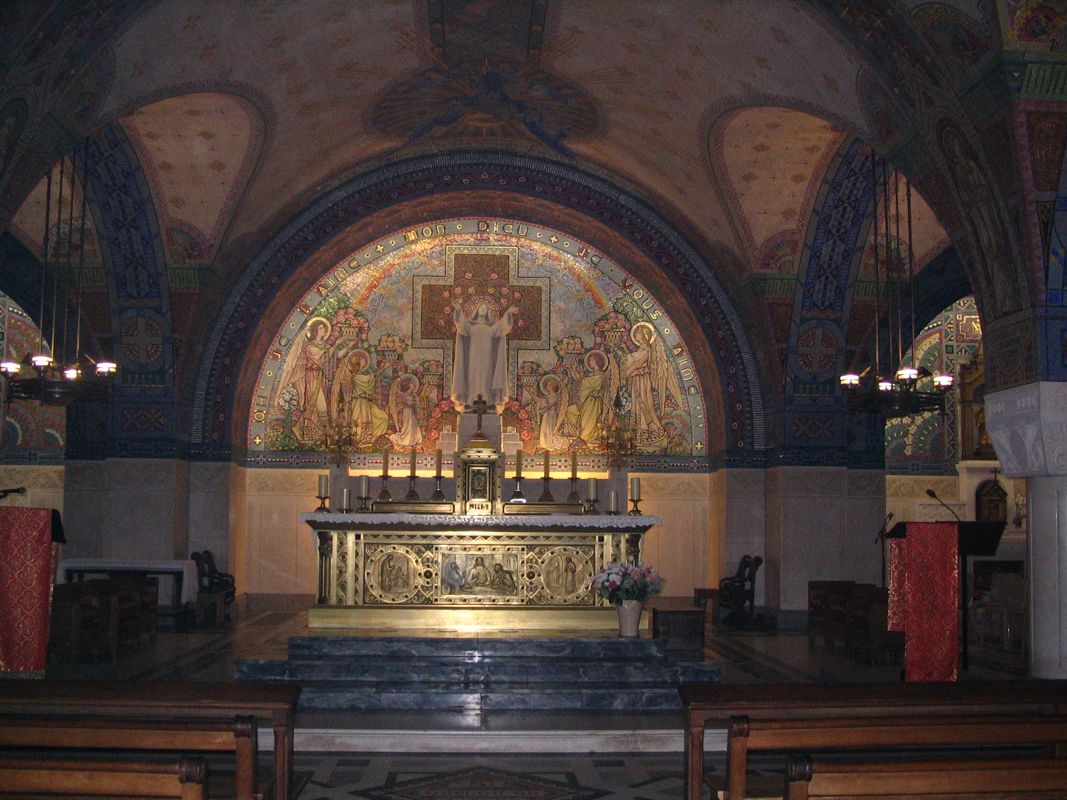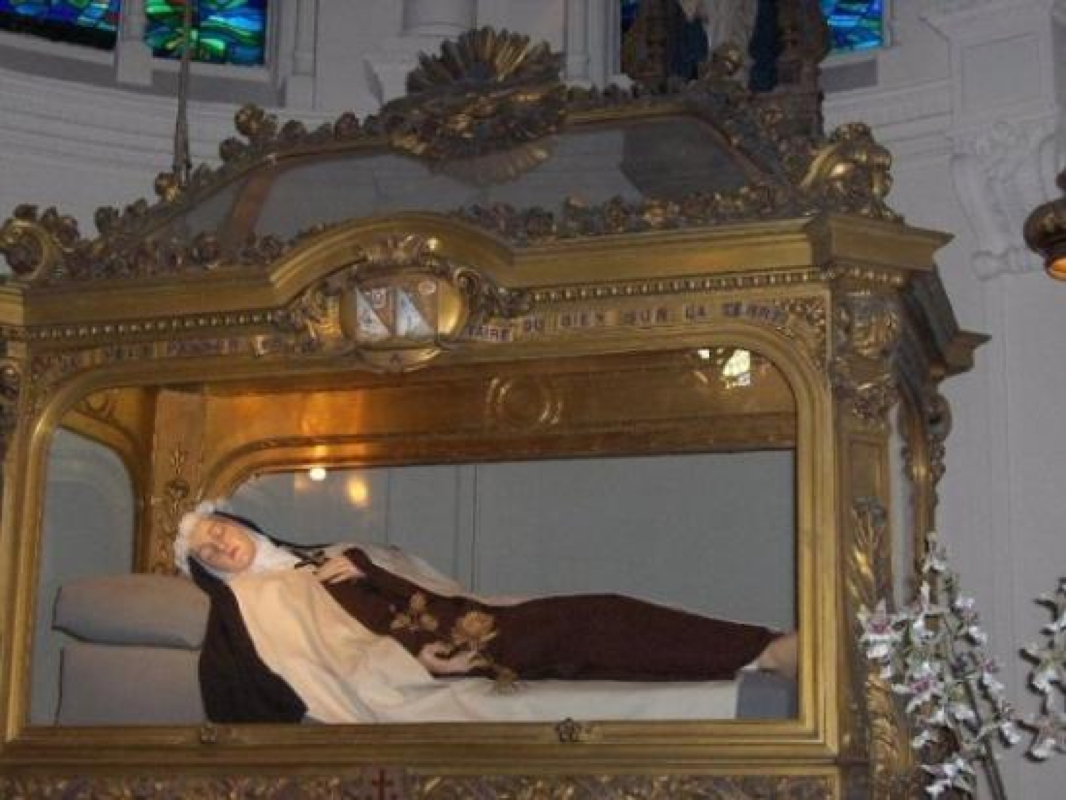Today I fulfilled a promise, a panata in Filipino, to visit St. Therese in her hometown in Lisieux in Lower Normandy. A panata is a unilaterally forged agreement with a religious personage, made by the supplicant as "payment" for divine favor that is granted. This transaction between deed and divine intervention is not so far from the mind of the Medieval French, who, under feudalism built the cathedrals that I have been eagerly frequenting. This was the running commentary in my head as my wife and I took the TER train from Rouen Rive Droite to Lisieux, at daybreak at 7am.
The train window frames the scenic view of Normandy's fields and towns coming to light from the darkness of the dewy morning, and I think of St. Therese and her book, Autobiography of a Soul, which I have read when I was a teenager. This saint who lived in modern times within the confines of a cloister of the Carmelite order, died at the age of 24. In photographs she is perpetually young, even as her words speak of a mind that is even more tender - and to my reading she sounds more like an adolescent gushing about her first love than a nun speaking of a way of religious life. Thus, this way I was enamored and it also helped that the church in Los Baños where I spent some Sundays during highschool weekends was dedicated to her. The parish priest then tried to wrestle me from bouts with atheism, and demonstrated a great store of knowledge about Buddhist meditation as a response to my comment that I have never met or heard a priest who wasn't a stupid bore. Pity I have never remembered his name, for he was the recipient of my very last confession as a Catholic.
But even as I removed myself from the liturgical and sacramental aspects of the religion of my baptism, I still retained my curiosity about the lives of the saints, with St. Therese as an exception. She was, in fact, the only saint whose words I could read (her book still remains with me, in e-book form in my Ipad) while I found the meditations and memoirs of St. Augustine, St. Teresa de Avila, St. John of God and St. Ignatius a bit obtuse and verbose. I recalled a teacher telling me that he found it surprising that I as young man would purchase Thomas a Kempis' Imitation of Christ and the Cloud of Unknowing - both treasures of the Medieval Catholic tradition. He laughed when I told him that I have even read St. Jose Maria Escriva, whose rightist conservatism appealed to me the very same time I plunged through Camus' The Stranger. He called my mind in a state of "philosophical discotheque" which I admit to be true, even to this day.
We arrived at the Lisieux train station just as the morning was unfolding at 8:07 am. From the platform we could see in half-light, the grandiose Basilique de Sainte-Thérèse standing on a hill. Aided by a hand-drawn map I made the night before, we climbed the ascending road to the church, chilled as we were from the frozen air. When we made it to the eponymous avenue that leads up to the plateau where the building rests, I scanned the hilly horizon of Lisieux and I cannot but help compare the landscape to Paete, or Liliw in Laguna with the cold wet atmosphere of Tagaytay or Benguet. It was a Saturday morning: nobody was in sight save for a utility man who drove a petrol-powered, foul-smelling, smoke belching motorcycle-drawn cart and collected the trash from the bins around the basilica grounds. The church would not be open until 9 am so we ventured to explore the areas behind it, and found the alcoves of the Stations of the Cross and the empty tombs of St Therese's parents, the Blessed couple Zellie and Henri Martin.
Fighting and cawing crows on the basilica dome punctuated the morning stillness of Lisieux. I asked my wife if she felt overwhelmed by places like these, because there are moments when I still am in disbelief when beauty saturates my senses. There is even a pang of insecurity that pervades my mind, and I reflect (almost spontaneously) if I was worthy to be in the presence of churches such as these. Or even landscapes that unfolded to us on our journey. I wonder if this is the culturally-induced meekness and insecurity complex that is the result of being from a poor and former colonized country. It is not on a few occasions that I have to reassure myself that there is nothing to be ashamed of, and that I am equally worthy to impose my sight and incorporate beautiful and sublime sites in the empire of my eyes.
The thought that bothers me often is the notion that I am walking in the land of the gods and overlords. So it was with some sort of vernacular comfort to see the work of Manuel Baldemor on the internal western wall of the Basilica. Mr. Baldemor was quick to provide the clue that his work is Filipino: the design corresponds to the tricolor and the sun of the flag. Looking at it while glancing at the neo-Byzantine design and mosaics nearby, made me think of an analogy of someone hollering balut! along Champs-Elysée. Pinoys would recognize and respond accordingly.
I stare at the oversized dimensions of the church. A brochure said that the architects thought of Sacre Coeur when they designed the building. This might be true for the exterior but inside the lack of obstructive columns reminds me of Hagia Sophia in Istanbul, where a dome surmounts a cubic form and leaves a central space vastly open. This, I thought, is an exaggeration of the spirit of St. Therese, the advocate of the Little Way. In this logic I cannot understand why the basilica is so huge...and so out of sync with the vision, ideas and words of this young Carmelite nun. Why neo-Byzantine? Why Sacre-Coeur in inspiration? St Therese herself prayed in a Norman Gothic cathedral, so why the reinvention of her vision? The only space I saw fitting to the spirit of the saint was the Crypt, which now holds the remains of her parents, a couple so exemplary they are on their own way to sainthood, being declared Blessed (the same rank of John Paul II who approved of their elevation).
So to ease my mind of all the discomforts of scale, my wife and I went to the Carmel convent where the saint spent her religious life with her four other sisters. On the way out of the Basilica and on the way into the Carmel church we noticed some burly men begging with plastic cups in their hands. My wife and I both remarked "ang lalaking tao hindi magtrabaho!" Perhaps we should be thankful that in Lisieux these men from Eastern Europe politely beg, when their counterparts in Paris do all sorts of scams and hustling, also in the name of charity.
At the Carmel, we stayed at the Tomb of Ste-Thérèse, staring at her marble sepulcher created in the likeness of her body when she laid in state after dying from tuberculosis. I told my wife that I did not agree with her expression of happiness when she learned that she was dying. It was years ago when I threw that yoke of the idea of life as a pilgrimage, that conscious, corporal existence is but a way station to the afterlife. I rebel at the idea that Therese and other saints take existence like it was some curse that one cannot wait to die and go to heaven. If God did create the universe and is the giver of life, why show him disrespect by ignoring creation and repressing life? Of course the answer lies in the socio-political dimension of Catholic religion as an effective proponent of feudal lifeworlds. The Church saw this fault itself and thus gave birth to the radical modernization of Vatican II in the mid-20th century. (Oh brother, I remember having read the documents of Vatican II as well! So as not to say I didn't give my old religion a fighting chance.)
My thoughts regarding my former faith is exemplified in the condemned building that is the beautiful Gothic Eglise de St-Jacques near the Lisieux Rotonde. Left unused since the1960s it is nevertheless a functional art exhibition space. This church stands as an edifice, but no longer functions as a religious front but as an aesthetic sanctuary. If there is a symbol of what I am attempting to do with my rebulto-work, St-Jacques is it. I am reclaiming the craft and techniques of rebulto-making in the name and domain of artistic practice.
Our last stop in Lisieux and on the heels of St Therese is the Cathdrale St-Pierre, where the saint's father donated a high altar. Although a cathedral, the church no longer hosts a bishop's seat since Napoleonic times. But its architecture remains a beautiful example of vernacular Norman architecture (the use of rectangular walls and a pyramidal roof) meeting with the Gothic (Latin cross design, tall columns, pointed arch, ribbed vaults and flying buttresses). The church also as several features connected with the Martin family and St Therese. It contains the chapel the Martin patriarch rents every sunday mass, the end-chapel where the Carmelite saint prayed for the conversion of a condemned murderer, and a confessional where she frequents both as a young girl and as a nun.
We were lucky enough to walk briskly enough to catch the first afternoon train back to Rouen, the rain having us running almost to the station. While waiting for the TER coaches to stop at the station I took one last gaze at the gigantic basilica of a little saint. My panata is fulfilled and in vernacular faith, this means a chance for another request. But I cannot utter one now. The church on the hill, like a white crown above the green, seemed to look back at me. And in a childish fashion (which seemed odd) I said goodbye for now and see you again - and waved.
St. Therese was a cute saint, after all. Wasn't she a pretty inspiration for an adolescent mind? Or wasn't she a playmate of my young intellect? She is the only saint that I consider human. All-too-human. And that makes her relevant.
The train window frames the scenic view of Normandy's fields and towns coming to light from the darkness of the dewy morning, and I think of St. Therese and her book, Autobiography of a Soul, which I have read when I was a teenager. This saint who lived in modern times within the confines of a cloister of the Carmelite order, died at the age of 24. In photographs she is perpetually young, even as her words speak of a mind that is even more tender - and to my reading she sounds more like an adolescent gushing about her first love than a nun speaking of a way of religious life. Thus, this way I was enamored and it also helped that the church in Los Baños where I spent some Sundays during highschool weekends was dedicated to her. The parish priest then tried to wrestle me from bouts with atheism, and demonstrated a great store of knowledge about Buddhist meditation as a response to my comment that I have never met or heard a priest who wasn't a stupid bore. Pity I have never remembered his name, for he was the recipient of my very last confession as a Catholic.
But even as I removed myself from the liturgical and sacramental aspects of the religion of my baptism, I still retained my curiosity about the lives of the saints, with St. Therese as an exception. She was, in fact, the only saint whose words I could read (her book still remains with me, in e-book form in my Ipad) while I found the meditations and memoirs of St. Augustine, St. Teresa de Avila, St. John of God and St. Ignatius a bit obtuse and verbose. I recalled a teacher telling me that he found it surprising that I as young man would purchase Thomas a Kempis' Imitation of Christ and the Cloud of Unknowing - both treasures of the Medieval Catholic tradition. He laughed when I told him that I have even read St. Jose Maria Escriva, whose rightist conservatism appealed to me the very same time I plunged through Camus' The Stranger. He called my mind in a state of "philosophical discotheque" which I admit to be true, even to this day.
We arrived at the Lisieux train station just as the morning was unfolding at 8:07 am. From the platform we could see in half-light, the grandiose Basilique de Sainte-Thérèse standing on a hill. Aided by a hand-drawn map I made the night before, we climbed the ascending road to the church, chilled as we were from the frozen air. When we made it to the eponymous avenue that leads up to the plateau where the building rests, I scanned the hilly horizon of Lisieux and I cannot but help compare the landscape to Paete, or Liliw in Laguna with the cold wet atmosphere of Tagaytay or Benguet. It was a Saturday morning: nobody was in sight save for a utility man who drove a petrol-powered, foul-smelling, smoke belching motorcycle-drawn cart and collected the trash from the bins around the basilica grounds. The church would not be open until 9 am so we ventured to explore the areas behind it, and found the alcoves of the Stations of the Cross and the empty tombs of St Therese's parents, the Blessed couple Zellie and Henri Martin.
Fighting and cawing crows on the basilica dome punctuated the morning stillness of Lisieux. I asked my wife if she felt overwhelmed by places like these, because there are moments when I still am in disbelief when beauty saturates my senses. There is even a pang of insecurity that pervades my mind, and I reflect (almost spontaneously) if I was worthy to be in the presence of churches such as these. Or even landscapes that unfolded to us on our journey. I wonder if this is the culturally-induced meekness and insecurity complex that is the result of being from a poor and former colonized country. It is not on a few occasions that I have to reassure myself that there is nothing to be ashamed of, and that I am equally worthy to impose my sight and incorporate beautiful and sublime sites in the empire of my eyes.
The thought that bothers me often is the notion that I am walking in the land of the gods and overlords. So it was with some sort of vernacular comfort to see the work of Manuel Baldemor on the internal western wall of the Basilica. Mr. Baldemor was quick to provide the clue that his work is Filipino: the design corresponds to the tricolor and the sun of the flag. Looking at it while glancing at the neo-Byzantine design and mosaics nearby, made me think of an analogy of someone hollering balut! along Champs-Elysée. Pinoys would recognize and respond accordingly.
I stare at the oversized dimensions of the church. A brochure said that the architects thought of Sacre Coeur when they designed the building. This might be true for the exterior but inside the lack of obstructive columns reminds me of Hagia Sophia in Istanbul, where a dome surmounts a cubic form and leaves a central space vastly open. This, I thought, is an exaggeration of the spirit of St. Therese, the advocate of the Little Way. In this logic I cannot understand why the basilica is so huge...and so out of sync with the vision, ideas and words of this young Carmelite nun. Why neo-Byzantine? Why Sacre-Coeur in inspiration? St Therese herself prayed in a Norman Gothic cathedral, so why the reinvention of her vision? The only space I saw fitting to the spirit of the saint was the Crypt, which now holds the remains of her parents, a couple so exemplary they are on their own way to sainthood, being declared Blessed (the same rank of John Paul II who approved of their elevation).
So to ease my mind of all the discomforts of scale, my wife and I went to the Carmel convent where the saint spent her religious life with her four other sisters. On the way out of the Basilica and on the way into the Carmel church we noticed some burly men begging with plastic cups in their hands. My wife and I both remarked "ang lalaking tao hindi magtrabaho!" Perhaps we should be thankful that in Lisieux these men from Eastern Europe politely beg, when their counterparts in Paris do all sorts of scams and hustling, also in the name of charity.
At the Carmel, we stayed at the Tomb of Ste-Thérèse, staring at her marble sepulcher created in the likeness of her body when she laid in state after dying from tuberculosis. I told my wife that I did not agree with her expression of happiness when she learned that she was dying. It was years ago when I threw that yoke of the idea of life as a pilgrimage, that conscious, corporal existence is but a way station to the afterlife. I rebel at the idea that Therese and other saints take existence like it was some curse that one cannot wait to die and go to heaven. If God did create the universe and is the giver of life, why show him disrespect by ignoring creation and repressing life? Of course the answer lies in the socio-political dimension of Catholic religion as an effective proponent of feudal lifeworlds. The Church saw this fault itself and thus gave birth to the radical modernization of Vatican II in the mid-20th century. (Oh brother, I remember having read the documents of Vatican II as well! So as not to say I didn't give my old religion a fighting chance.)
My thoughts regarding my former faith is exemplified in the condemned building that is the beautiful Gothic Eglise de St-Jacques near the Lisieux Rotonde. Left unused since the1960s it is nevertheless a functional art exhibition space. This church stands as an edifice, but no longer functions as a religious front but as an aesthetic sanctuary. If there is a symbol of what I am attempting to do with my rebulto-work, St-Jacques is it. I am reclaiming the craft and techniques of rebulto-making in the name and domain of artistic practice.
Our last stop in Lisieux and on the heels of St Therese is the Cathdrale St-Pierre, where the saint's father donated a high altar. Although a cathedral, the church no longer hosts a bishop's seat since Napoleonic times. But its architecture remains a beautiful example of vernacular Norman architecture (the use of rectangular walls and a pyramidal roof) meeting with the Gothic (Latin cross design, tall columns, pointed arch, ribbed vaults and flying buttresses). The church also as several features connected with the Martin family and St Therese. It contains the chapel the Martin patriarch rents every sunday mass, the end-chapel where the Carmelite saint prayed for the conversion of a condemned murderer, and a confessional where she frequents both as a young girl and as a nun.
We were lucky enough to walk briskly enough to catch the first afternoon train back to Rouen, the rain having us running almost to the station. While waiting for the TER coaches to stop at the station I took one last gaze at the gigantic basilica of a little saint. My panata is fulfilled and in vernacular faith, this means a chance for another request. But I cannot utter one now. The church on the hill, like a white crown above the green, seemed to look back at me. And in a childish fashion (which seemed odd) I said goodbye for now and see you again - and waved.
St. Therese was a cute saint, after all. Wasn't she a pretty inspiration for an adolescent mind? Or wasn't she a playmate of my young intellect? She is the only saint that I consider human. All-too-human. And that makes her relevant.




 RSS Feed
RSS Feed